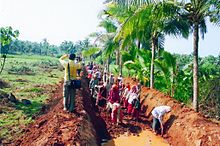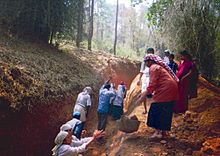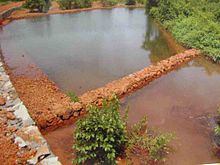- NREGS (Kerala)
-
The National Rural Employment Generation Scheme (NREGS) is a historic employment scheme in India for providing 100 days guaranteed wage employment for all employment seekers above 18 years of age and willing to do work. The scheme came into force on 5th September 2005 in 200 districts in India and extended to another 130 districts later.
In Kerala, the scheme was implemented in Palakkad and Waynad districts initially on 5th February 2006 and it was extended to all the 14 districts in the State on 1st April 2008. Kerala is a tiny state in India with very high unemployment - most of them are educated - in the country. Around five lakh people among them are estimated to have willingness to do physical labour. NREGS is a substantial boost in income and purchasing power. The scheme now provides Rs 125 (National wage rate is Rs 60/- only) per person for a stipulated quantity of manual labour offered as registered worker in the local governments in Kerala.
Contents
Features of the scheme
• Local governments are given a central role in the planning and implementation of NREGA ( National Rural Employment Guarantee Act 2005) and are the sole agencies responsible for implementation of local development projects under the scheme in Kerala
• Engineering support is put in place. In addition to one diploma/degree holder working on contract at the level of the Village Panchayat, there is a system of accredited engineers. Such engineers are drawn from amongst retired engineers, staff working in Engineering Colleges, Polytechnics/ ITIs, engineers working in NGOs etc. These engineers are paid for their work, at rates fixed by Government. The engineer from a government department or agency, willing to help the Village Panchayat over and above his normal work, is allowed and paid at 50% of the rate applicable to others.
• Technical Sanction of the work is given not by individual engineers, but by a Technical Committee of engineers which includes a government engineer, a retired engineer and an engineer working in an academic institution for the purposes of transparency.
• An appellate system has been put in place at the district level to facilitate speedy sorting out of disputes.
• To mobilize the workers and the public and to assist the local governments in carrying out its duties, Village Panchayats have been given the freedom to identify one public servant of their choice having the time and inclination to do social work from any government department are posted on working arrangement as NREGS co-coordinators.
• Kudumbasree is given in the implementation of the programme. Under Kudumbasree every family below poverty line is organzied into a Neighbourhood Group (NHG) at the local level consisting of 15 to 40 families with each family being represented only by a woman. The NHGs are federated into an Area Development Society (ADS) at the level of the Ward of the Village Panchayat (a Village Panchayat Ward in Kerala has a population of around 1500 to 2000). The ADSs in a Village Panchayat are federated into a registered body called the Community Development Society (CDS). Each NHG, ADS and CDS has five volunteers carrying out different functional roles. • The ADS has been entrusted with the task of organizing public works under NREGS. Muster Rolls and other records are maintained by the ADS, implements are provided to labourers by them and the transparency and monitoring requirements are also carried out by them. Welfare amenities to the workers are also provided by the ADS. Since ADS is an organization of the poor and is basically a woman's group, there has been greater sensitivity and community participation in the implementation process.
• The estimates are summarized in the local language so as to be understood by ordinary people. At the beginning of every work, the nature of work, expected out turn and the likely wages are explained to the workers' groups.
• Since Kerala has limited public land, the eco-restoration works are selected for in degraded forest lands. Village Panchayats would implement the programme in forest areas with the technical supervision being done by field level officials of the Forest Department representing a new kind of relationship between a Panchayat Raj Institution and a government department.
• The road works has been limited to 10% of the total expenditure and to give special priority to integrated watershed development works.
Major advantages
Compared to the earlier wage employment programmes such as NREGA, RLEGP, JRY, EAS, SGRY, IRDP, SGSY there are significant achievements under NREGS due to the combination of transparent processes and procedures, local action and constant vigilance. The implementation of NREGA has been comparatively corruption free. The factors contributing to this situation include: -
§ A clear political decision was conveyed to the Panchayats that the scheme has to be implemented strictly as per the laws in force. The argument for an asset focused programme ignoring the processes and conforming to the procedures on paper,was rejected. The argument that Kerala would lose out as the demand for unskilled labour is very limited and as the wages are much higher than the statutory minimum wages in more than 90% of the State, it would be better to go for public works, was rejected.
§ The work is organized through the Kudumbashree system and the poor have a stake in the work right at the beginning.
§ The technocratic power to accord Technical Sanction, measure works and recommend payments has been made more spread out and accountable through the Committee system.In case of difference of opinion the appellate system would be resorted to.
§ Special emphasis has been given to the rights of workers and they have been made fully aware of their entitlements.
§ All the payments are made only through the individual bank accounts of workers. This is the ultimate preventer of corruption.
Yet there are apprehensions that once material purchase starts, corruption would come in, in some form or the other. The state is earnestly put in a system which deters corruption.
Women empowerment
Implementation of NREGA has contributed to very high levels of women empowerment, particularly in the following aspects.
• As the work is organized by women’s groups, the gender perspective gets built in automatically.
• As women are comfortable working along with their neighbourers, nearly 80% of the workers have been women.
• For the first time equal wages are really paid and this has boosted the earnings of women.
• As the wages are paid into Bank accounts the habit of thrift which was already incalculated through the Kudumbashree experiment has further been strengthened.
• As the Bank deposits are increasing, the intra-household status of the woman has also been improving commensurately as she controls substantial cash resources and withdrawal can be only on her decision.
Systems and procedures
NREGS can give rise to a new work culture. The workers were hitherto controlled by contractors and their middlemen who knew how to extract work. When NREGS began the out-turn was very poor as the workers could not be supervised properly. But soon the workers themselves realized that they would be losing collectively and a new internal dynamics evolved with peer pressure forcing workers to put in their maximum effort. At the same time a kind of social responsibility also became evident as more capable workers became more than willing to put in extra effort to make up for those who genuinely could not do hard work beyond a point, like the women and the elderly.
Public works have gained respectability. Hitherto they were seen as highjacked either by a contractor or a local leader. Now the workers see it as their right. They tend to distinguish between wages provided by a contractor and wages directly given by the Panchayat. The latter is almost equated with a salary. This has motivated a large section of people who were hitherto unwilling to work into join the work force.
There was an interesting instance of a penurious descendant of the erstwhile Kollengode royal family in Palakkad taking an active part in NREGS and even motivating her relatives to join on the logic that self-help and access to legally entitled emoluments from a public source is better than charity from relatives
Integration with other activities
A strong natural resource management focus has been given to NREGS. Bharathapuzha River rejuvenation with action plans emanating from the Village Panchayat as building blocks was taken up as a mega project under the scheme.
Attempt is on to integrate NREGS and People’s Plan. Village Panchayats get more than Rs.1 crore on an average under People’s Plan. If intelligently dovetailed it is expected that substantial improvement in quality of assets can be attained. In order to overcome the problem of shortage of technical staff, it has been decided to rope in voluntary services of reputed non-government organizations. Using the excellent network of Kudumbashree it has been decided in the State Employment Guarantee Council to develop a cadre of bare-foot technical volunteers from among the poor women. In order to develop the skills of the workers it has been decided to set up Labour Banks. A pilot has been launched in one Village Panchayat. The Labour Banks would be supported under People’s Plan to take up other public works and even private works. It is well-nigh impossible to identify works in the plantation areas as well as in the coastal areas. It has been decided to seek the expert support from Government of India to come out with a shelf of projects which can be taken up in such geographical areas.
An innovative form of training has been developed by Kerala Institute of Local Administration (KILA) where there is a shift from the cascading model to a “ripple” model, according to which outstanding Panchayats become the master trainers and the neighbouring Panchayats formally learn from the experience of the best performers. Monitoring has been strengthened with the decision of the State Employment Guarantee Council to put in a system of State level and District level quality Monitors by identifying persons with reputation for integrity and competence. The State level Monitors would be of two categories – outstanding individuals whose views are widely respected by society and senior Technical Experts capable of giving authoritative feed back on the quality of implementation. Further the State Employment Guarantee Council has decided to request a team consisting of eminent experts to conduct an independent assessment of Kerala’s performance and offer suggestions for improvement.
A good beginning
Though there were several teething problems it is clear that the policy focus on natural resource management and corruption-free implementation and the administrative measures introduced to operationalise the policy especially the involvement of the Kudumbasree network have resulted in a strong foundation being laid and opened up space for pro-poor innovations.
NREGS has suddenly increased purchasing power of the poor and there is visible local economic development. This is particularly true of Wayanad which was ridden with farmer suicides. The peasants have managed to get substantial relief from NREGS by getting over their inhibition in working as labourers in richer farmer’s lands by moving on to the now-respectable public works[1].
A recent study conducted by Chathukulam and Gireesan, of Centre for Rural Management ( CRM) indicated that major defects identified during previous wage employment programmes were absent in the NREGS in the State and provision of equal wages to men and women, non-involvement of contractors, very limited use of machinery, adherence to wage- material ratio etc were followed and the absence of muster roll manipulations was absent in the execution of the program in the initial two districts of Palakkad and Wayanad[2].
References
External links
Government orders on NREGS in Kerala
A webpage on Status of NREGA in Kerala
NREGA Status in the State of Kerala
Implementation of NREGS : Experience in Kerala by S M Vijayanand and V N Jitendran
Government of Kerala – Order on implementation of the scheme in forest areas in Kerala
Draft CAG Report on NREG scheme ( Accessible to gmail subscribers)
NREGA : Ship without rudder by Dr Jean Dreaze
NREG implementation poor in state
How is NREGA doing? By Jean Dreze and Christian Oldiges
Power-Point Presentations on NREGA
NREGA Citizens Report, UN Solution Exchange
A critique of the National Rural Employment Guarantee Act 2005
See also
- National Rural Employment Guarantee Act
- Local Governance in Kerala
- Kudumbashree Mission (Kerala)
Categories:- Local government in Kerala
- Rural development in India
Wikimedia Foundation. 2010.



